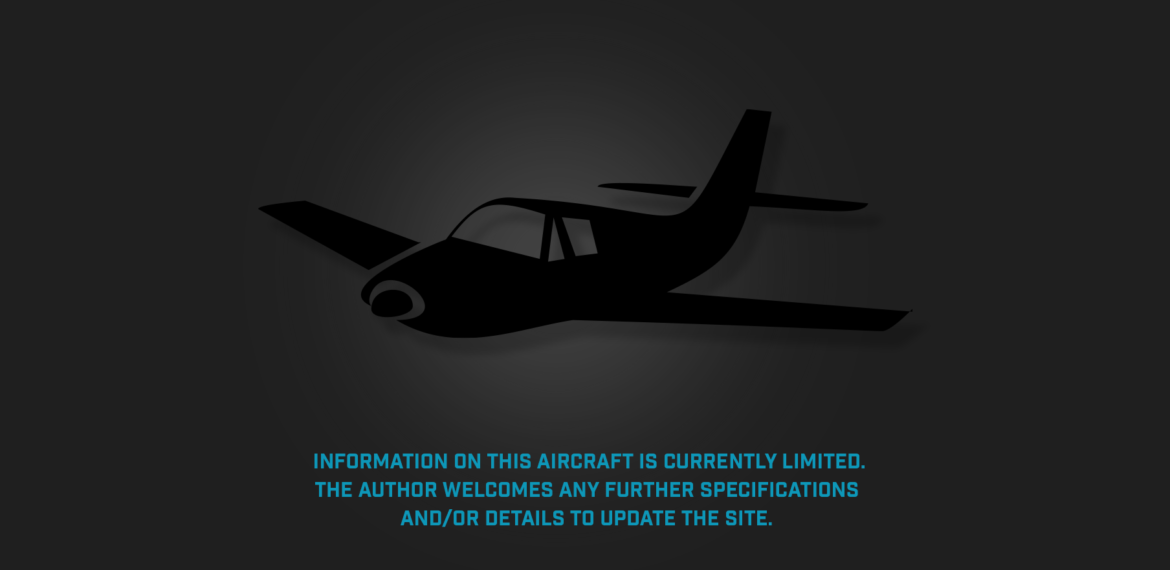Photograph:
Blohm & Voss Bv 141 test aircraft in Luftwaffe markings during World War II (Bundesarchiv)
Country of origin:
Germany
Description:
Three-seat military reconnaissance monoplane
Power Plant:
One 1,231 kw (1,650 hp) BMW 801A fourteen-cylinder two-row air-cooled radial engine
Specifications:
- Wingspan: 17.46 m (57 ft 3 3/8 in)
- Length: 13.95 m (45 ft 9¼ in)
- Height: 3.6 m (11 ft 9¾ in)
- Wing area: 53 m² (570 sq ft)
- Max speed at sea level: 370 km/h (230 mph)
- Service ceiling: 10,000 m (32,808 ft)
- Normal range: 1,200 km (745 miles)
- Fuel capacity: 490 litres (108 Imp gals)
- Empty weight: 4,700 kg (10,363 lb)
- Loaded weight: 5,700 kg (12,568 lb)
Armament:
Two 7.9 mm (0.31 in) MG15 fixed machine guns in nose; two 7.9 mm (0.31 in) hand-held machine guns
in rear of cockpit; provision to carry four 50 kg (110 lb) SC50 bombs
History:
Built in relatively small numbers, the Blohn & Voss Bv 141 reconnaissance aircraft was unusual in being of asymmetrical concept in that the pilot and crew were seated in a nacelle offset to starboard of a boom carrying the engine and tail assembly. Conceived by Dr Richard Vogt whilst working for Kawasaki in Japan upon his return to Germany in 1937, the design was submitted to compete in a competition to develop a reconnaissance aircraft for the Luftwaffe, the main other contenders being the Focke Wulf Fw 189 Uhu and the Arado Ar 198.
A prototype known as the Bv 141 V2 D-ORJE (c/n 172 – originally known as the Ha 141-O) was built at the Hamburger Flugzeugbau, the aircraft department of the Blohm & Voss shipyards where the battleship ‘Bismarck’ was constructed, first flying on 25 February 1938 in Hamburg powered by an 846 kw (1,000 hp) Bramo 323 air-cooled radial engine. This aircraft was later fitted with a BMW 132 nine-cylinder air-cooled radial engine. Dimensions were a wingspan of 15 m (49 ft 2½ in) and a length of 11.1 m (36 ft 5 in).
The cabin nacelle carried a crew of three, one machine gun being installed in the nose, and bombs could be carried under the wing. Vogt believed that in order to provide all-round adequate vision for reconnaissance purposes in a single-engine aircraft, it was necessary to adopt an asymmetrical configuration. The crew nacelle accommodated the pilot to port with the observer to starboard, the observer’s seat being fitted with rollers so that, when pushed to the forward extremity of its track, this crew member could operate the bomb sight. He also operated the camera, and on occasions the upper aft-firing machine gun.
Trials were successful and a further prototype, the Bv 141 V2, also known as the Ha 141-O, D-OTTO (c/n 171), which was the first official prototype, and which was slightly larger than the earlier aircraft, was completed and made its first flight in September 1938. Later a production prototype, the Bv 141 V3 D-OLGA (c/n 359), was built. This had a lengthened fuselage to 12.15 m (39 ft 10 1/3 in) to improve directional stability.
The Reichs-Luftfahrts-Ministerium (RLM) Technical Directorate approved production and Major General Ernst Udet flew an example, performing a series of aerobatics. The Bv 141 V2 had some re-design to the cockpit nacelle and at this stage it was decided to fit the 1,194 kw (1,600 hp) BMW 801 radial engine to pre-production aircraft, these to be known as the Bv 141A-0 series. The installation of this more powerful engine required a complete structural re-design of the airframe, a mock-up being built and presented to the RLM on 14 February 1940.
Testing revealed the symmetrical tail restricted the field of fire for the rear machine-gun and an asymmetrical tailplane was designed for the Bv 141B-0 series, the first of which was the Bv 141 V9, which made its first flight on 9 January 1941, later being delivered to the Rechlin Test Centre in Mecklenburg-western Pomerania in May 1941. An order was placed for five Bv 141B-0s and options were held on a further five pre-production and ten production aircraft. However, during testing it was found the performance of the Bv 141 was inferior to the Fw 189 and only a small batch of Bv 141B-0s was completed.
The Bv 141 often suffered with hydraulic problems, this resulting in a number of crash landings due to an inability to extend the undercarriage. Teething troubles were considerable, and the last aircraft built, the Bv 141B V13 was not delivered until 15 May 1943. Eventually it was decided to abandon development of the type in favour of production at the Blohm & Voss plant of the Focke Wulf Fw 200 Condor series.
An order was issued that a ‘Special Squadron Bv 141’ was to proceed to the Russian front but the unit was not set up and the order was cancelled in 1942. German propaganda during the war referred to large scale production of the Bv 141 and operational use of the type on the Russian front but it appears in fact it saw no service on any front and only some thirteen aircraft were completed.
In 2004 at the Serpentine sports field in Western Australia a group commenced the construction of a replica of a Bv 141 which will be fitted with a 746 kw (1,000 hp) radial engine when completed.

